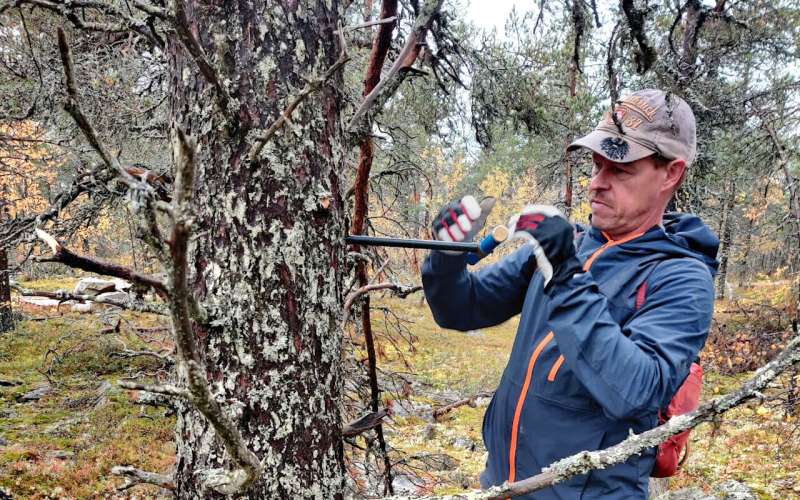This article has been reviewed according to Science X's editorial process and policies. Editors have highlighted the following attributes while ensuring the content's credibility:
fact-checked
peer-reviewed publication
trusted source
proofread
Tracing the largest solar storm in modern times from tree rings in Lapland

A research group coordinated by the University of Helsinki was able to measure a spike in radiocarbon concentration of trees in Lapland that occurred after the Carrington flare. This discovery helps to prepare for dangerous solar storms. The study is published in the journal Geophysical Research Letters.
The Carrington Event of 1859 is one of the largest recorded solar storms in the last two centuries. It was seen as white light flares on a giant sunspot group, fires at telegraph stations and disturbances in geomagnetic measurements, as well as auroras even in tropical regions.
In a joint study carried out by the University of Helsinki, Natural Resources Institute Finland and the University of Oulu, a sign of an increase in radiocarbon concentrations following the Carrington storm was detected for the first time in tree rings. Previously, radiocarbon traces have only been detected from far more intense solar storms.
Discovery through a cosmic marker
Encounters between strong magnetized clouds of charged particles released from the sun, known as solar plasma flows, and Earth's geomagnetic field result in geomagnetic storms. The geomagnetic field directs the solar storm particles into the atmosphere primarily through the Polar regions. The most visible consequence of the phenomenon are auroras.
In the upper atmosphere, sufficiently high-energy particles can, through nuclear reactions, also produce radiocarbon (14C), a radioactive isotope of carbon. Over the course of months and years, radiocarbon ends up in the lower atmosphere as part of atmospheric carbon dioxide, and eventually in plants through photosynthesis. The process of photosynthesis preserves the information contained in carbon dioxide in the annual rings of trees.
To obtain the information held by radiocarbon, samples are extracted by carving from the wood material grown over individual years. The samples are processed to cellulose and the cellulose into pure carbon by burning and chemical reduction. The fraction of radiocarbon in pure carbon is measured using a particle accelerator.
"Radiocarbon is like a cosmic marker describing phenomena associated with Earth, the solar system and outer space," says Markku Oinonen, Director of the University of Helsinki's Laboratory of Chronology, who headed the study.
Mapping solar storms
A solar storms corresponding to the Carrington event in modern times would disrupt electrical and mobile networks and cause major problems for satellite and navigation systems, leading to problems in, for example, air traffic. This is why accurate knowledge of solar behavior benefits society.
Solar storms smaller and more common than the Carrington storms can be studied with measuring devices and satellites nowadays, while larger ones can be investigated, for example, by measuring radiocarbon concentration in tree rings.
So far, it has not been possible to study specifically medium-sized storms such as the Carrington event, which have not occurred in modern times, using conventional radiocarbon techniques. This recent study opens up a potential new way of investigating the frequency of Carrington-sized storms, which may help to better prepare for future threats.
Increasingly accurate information on the carbon cycle
The results were interpreted using a numerical model of radiocarbon production and transport developed by researchers at the University of Oulu.
"The dynamic atmospheric carbon transport model was specifically developed for describing geographical differences in the distribution of radiocarbon in the atmosphere," says Postdoctoral Researcher Kseniia Golubenko from the University of Oulu.
What was significant in the recently published study was how the radiocarbon content of trees in Lapland differed from that of trees at lower latitudes. The first measurements were carried out at the Accelerator Laboratory of the University of Helsinki, while repeat measurements conducted in two other laboratories significantly reduced the previous uncertainties.
The discovery can help to better understand atmospheric dynamics and the carbon cycle from the time before human-generated fossil fuel emissions, enabling the development of increasingly detailed carbon cycle models.
"It's possible that the excess of radiocarbon caused by the solar flare was primarily transported to the lower atmosphere through northern regions, contrary to the general understanding of its movement," says Doctoral Researcher Joonas Uusitalo from the Laboratory of Chronology.
Other sources of radiocarbon
"It's also possible that the cyclic change in the production of radiocarbon in the upper atmosphere caused by the variation in solar activity has resulted in the local differences on the ground level seen in our findings," Uusitalo adds.
According to Uusitalo, the dominant fraction of radiocarbon is produced by galactic cosmic rays coming from outside the solar system, even though exceptionally strong solar storms generate individual bursts of the isotope in the atmosphere. Cosmic rays, in turn, are weakened by solar wind, a continuous flux of particles originating in the sun that fluctuates between stronger and weaker in 11-year cycles.
The topic requires further research. Historical records show that significant geomagnetic storms also took place in 1730 and 1770, which is why their tracking is likely to be in focus next.
The study was carried out as a collaborative project of the University of Helsinki's Laboratory of Chronology and Department of Physics, and Natural Resources Institute Finland. Researchers from the University of Oulu, Nagoya University, Yamagata University and ETH Zurich also contributed to the study.
More information: Joonas Uusitalo et al, Transient Offset in 14C After the Carrington Event Recorded by Polar Tree Rings, Geophysical Research Letters (2024). DOI: 10.1029/2023GL106632
Journal information: Geophysical Research Letters
Provided by University of Helsinki




















